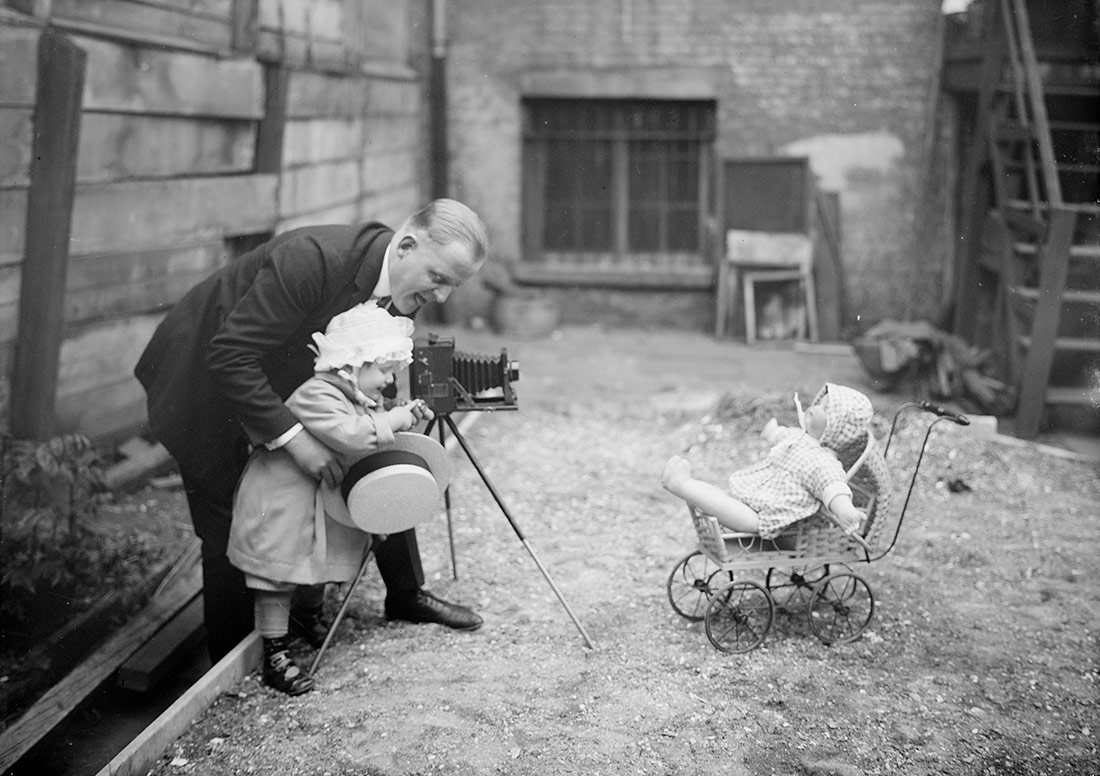
A man with a girl, photographing a doll in a baby carriage, 1915-120 | Library of Congress | Public domain
TikTok’s algorithm has changed the way we access content on social media. While previously we followed users, we’re now sucked in by trends. This has had a significant effect on the panorama of cultural creation, impacting everything from the type of work produced to the relationship between artist and public and the role of critics and tastemaking.
There’s something about TikTok that reminds me of the success of popular sweets – half the world likes it despite its low nutritional value. And, as in the world of chocolate and sweets, its competitors try to reproduce the formula to capture some of its market share. In the case of the Chinese platform, we caught a first glimpse of this after it consolidated its position in the West, following the coronavirus pandemic. Locked down in their homes, millions of people found that its content offered a quick form of entertainment – short videos on a very wide variety of specific topics. Its popularity was so dizzying that, among other things, it forced Instagram to reinvent itself by coming up with Reels and YouTube with Shorts.
TikTok’s secret lies not only in the length of its videos, but also in its algorithm, which brings up ultra-personalised content based on a very detailed set of data which includes the videos shared between users and the viewing time of each one, even if they haven’t ‘liked’ the clip. And the satisfying experience it offers isn’t just for consumers, it also takes in the content creators – the ‘For You’ tab shows accounts both with and without lots of followers, because the platform’s goal is also to give visibility to those who are just starting out. Coupled with an easy way to create and edit videos, it’s faster and easier for content creators to grow than on the other popular platforms.
In other words, TikTok wants you to discover new creators all the time, while also rewarding newbies by giving them more exposure – a loop that rewards both sides with dopamine. It’s a system that works well in terms of attention and plays, but it affects the generation of communities, because users no longer follow people so much as trends, which by definition are fleeting.
This situation is putting the creative industries on alert, and some people have even begun to criticise it. This is the case of Jack Conte, co-founder of the platform Patreon, who in his talk at this year’s SXSW festival highlighted some of the problems with the current recommendation algorithms. Conte mentioned how, until recently, creators would post content and, if users were interested in the material, they would click ‘follow’ or subscribe to their channel. The more content they posted, the more their audience grew. This is how the logic of followers works, one of the central aspects of Web 2.0. But now things have changed – users’ feeds are based less on the accounts they follow than on the topics that interest them. Ergo, the connection between the creator and the audience has weakened.
On the other side of the screen, this doesn’t seem like an ideal situation either. Apart from the creators, does this benefit or harm consumers? It’s difficult to say, because there are conflicting opinions. If we take the case of a platform like Spotify, users have access to an endless amount of music through an affordable monthly subscription (or at least that’s the optimistic argument), but this very fact leads to a fragmented and anxious consumption in which people listen to tracks before discarding them (although not before tapping out a story or a tweet). This explains, at least partly, why the most popular music today (as can be seen in the platform’s own charts) are songs with an immediate impact, which get the choruses or melodic hooks in at the beginning. It’s also no coincidence that the narrative of success in this industry is currently measured in the number of plays or sell-outs, while overlooking aspects more intrinsically linked to artistic production or, to put it in Benjaminian terms, materialist aesthetics.
The possibility of access to virtually unlimited content changed the rules of culture, and also the role of critics, as their expertise no longer carries the same weight as before. In a recent article for The Atlantic, writer W. David Marx discusses how “cultural arbitrage” has changed in the past few years. “In the past, tastemakers in the worlds of fashion, art, and music established careers through this sort of arbitrage – plucking interesting developments from subcultures to dangle as novelties in the mass market,” Marx writes, “But the internet’s sprawling databases, real-time social-media networks, and globe-spanning e-commerce platforms have made almost everything immediately searchable, knowable, or purchasable – curbing the social value of sharing new things. Cultural arbitrage now happens so frequently and rapidly as to be nearly undetectable.”
That past, however, is only recognisable to those who experienced it. It would be unfair not to point out that TikTok also brought Generation Z into contact with content which would have otherwise been difficult for them to access. This is a generation that is not only used to living in a hyper-connected world, but also to being prosumers, which is why certain disciplines once considered specialised, even elitist, are now popular thanks to the creativity of good community managers. For example, the fashion analysis around events such as the Met Gala, the geopolitics of international conflicts, or museology, which brings a fresh perspective to classic works of art in order to attract a young audience.
Here again, the pandemic had a crucial impact. When they were forced to shut shop for months, many organisations had to resort to the virtual space to stay relevant. The Uffizi Gallery in Florence became a paradigmatic case when it began to publish videos on TikTok with explanations of some of the paintings in its collection, which were somewhat irreverent and with contemporary songs in the background, but without drifting off-point from telling the story of a work of art. Other more modest museums also found that the Chinese platform was a good space for reaching more people, and even the specialised publication The Art Newspaper published an article last December in which it recommended that museums have a TikTok specialist on their staff (TikTok itself has invested in giving the creators of educational content greater reach).
However, it’s worth noting that it’s not easy for quality content on TikTok to reach its audience if it’s surrounded by gimmicky videos designed for engagement and light consumption, like those sweets we mentioned at the beginning. Invisibility is a constant risk in this new cultural industry scenario, forcing players to get used to a kind of paradox – interacting with trends, but without losing their authenticity. To continue with the gastronomic metaphor, it is the attempt to provide some protein in the middle of a Doritos binge, as suggested by a popular theory created, of all places, on TikTok.
Looking back over the history of the past few decades, we can see that whenever new formats have arrived, they have always threatened to consign the old ones to the rubbish heap. But they have only succeeded with the less interesting ones, because television did not kill cinema, and music festivals did not spell the end of gigs in dingy pubs. And so it is that, between fruit-peeling tutorials, videos of mischievous kittens and frenetic dance moves, the epic story behind a painting or a novel may slip in. After all, if there’s one thing a classic must prove, it’s its ability to survive the centuries.




Leave a comment